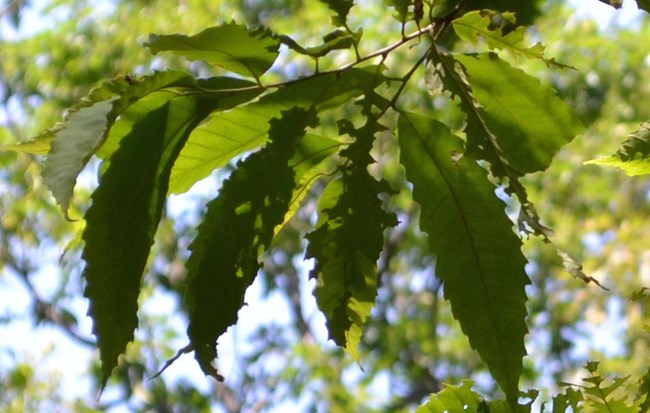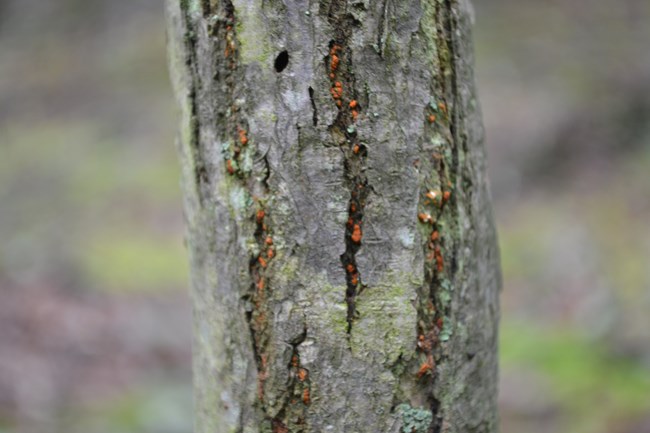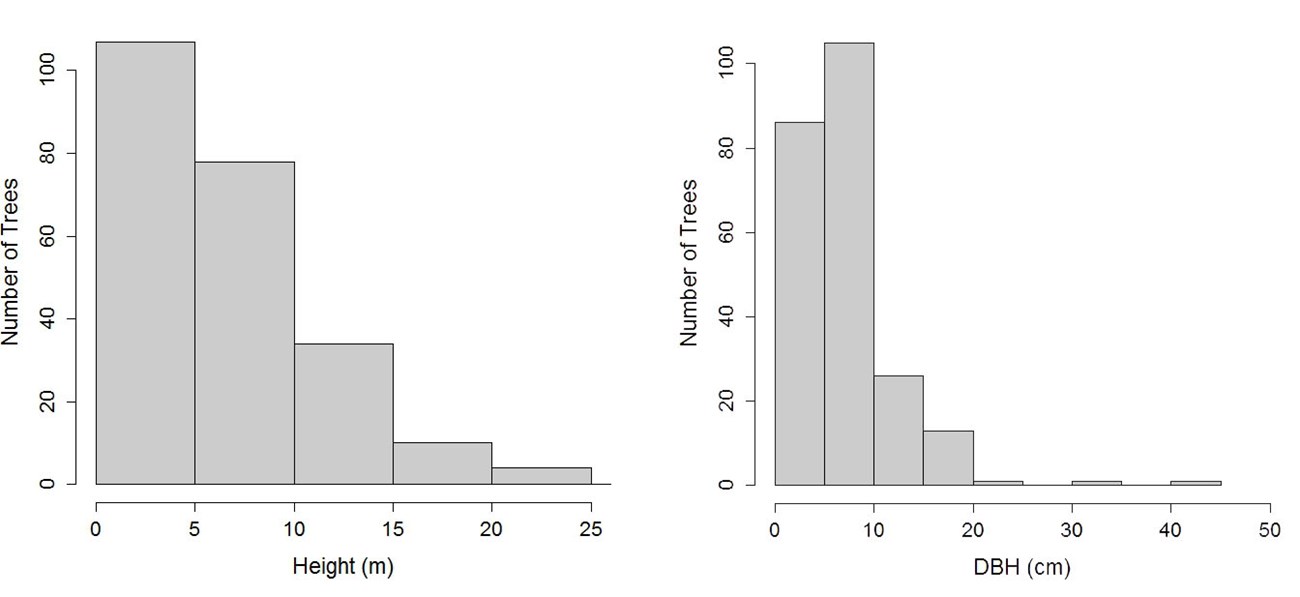Last updated: February 27, 2025
Article
American Chestnuts in the Capital Region

NPS
The American chestnut was once a dominant tree of the eastern U.S. known for its rot resistant wood and ample production of wildlife-supporting chestnuts. While it was nearly wiped out by disease, survivors still exist today in several national parks in the greater Washington, DC area.
A Deadly Disease
The American chestnut tree (Castanea dentata) once occupied forests as far south as central Alabama, west through Tennessee, and as far north as Maine and southern Ontario. In some forests, they made up more than half the mass of living trees.
In 1904 however, the non-native chestnut blight fungus (Cryphonectria parasitica) was introduced and quickly spread through forests of the eastern U.S. By 1950, almost all American chestnuts in their native range were dead.
But because the blight fungus does not kill the root system of trees, American chestnuts persist today in natural areas as re-sprouts from blight-free root systems.

NPS/Reidman
Looking for Survivors
Because of its ecological function, historical importance, and the fact that the National Capital Region (NCR) is part of its native range, many people are interested in bringing American chestnuts back to NCR forests.
To better understand their current status, National Park Service staff from the National Capital Region Network, Inventory & Monitoring (NCRN I&M) program inventoried American chestnuts in eleven NCR parks in 2014. We collected location information for each living tree, measured diameter at breast height (dbh) of all stems greater than 1 cm dbh, estimated height for the tallest stem, classified each tree’s position in the forest caonpy, and recorded the visual presence of blight symptoms and reproductive structures including flowers and fruit.
Results
We found living American chestnut trees in every National Capital Region park except Antietam and Manassas (see table below). In all, we documented 234 trees.
| Park | # Living Trees | # Reproductive Trees |
|---|---|---|
| Catoctin Mountain Park | 98 | 4 |
| C&O Canal National Historical Park | 3 | 0 |
| George Washington Memorial Parkway | 27 | 0 |
| Harpers Ferry National Historical Park | 46 | 1 |
| Monocacy National Battlefield | 1 | 0 |
| National Capital Parks - East | 5 | 0 |
| Prince William Forest Park | 5 | 1 |
| Rock Creek Park | 20 | 0 |
| Wolf Trap National Park for the Performing Arts | 29 | 1 |
The majority of the trees were small (see graphs below), with diameters (measured as DBH or diameter at breast height) ranging from 1.5 to 42.5 cm (average=7.3 cm) and heights ranging from 1.4 to 23.9 meters (average=6.8 m). Most were understory trees; 91% were classified as “overtopped,” meaning that the tree’s crown is entirely below the level of the canopy and receives no direct sunlight. Only one tree was tall enough to reach the forest canopy. We found evidence of reproduction (flowers and/or fruit) at seven trees. Eleven percent of the trees we inventoried showed at least one visual symptom of chestnut blight.
Complete American chestnut inventory data includes a geodatabase in which each park in the NCR has one folder containing shapefiles with chestnut locations, monitoring tracklines, and area surveyed. Data on size, health, and other characteristics are also included.

NPS
Future Restoration
Restoration of American chestnuts to long-term, self-sustaining and naturally reproducing populations is still a far-off goal. Since the near devastation of the blight, university scientists, non-profit organizations, and others have worked to create hybrid, blight-resistant chestnut trees and to find naturally resistant survivors.In 2009, NPS signed a memorandum of understanding with The American Chestnut Foundation (TACF) allowing parks to “assist TACF in its goal of restoring American chestnut to the forests of the eastern United States” and giving preference to NPS as a “most favored recipient” of chestnut trees offered by TACF.
Learn More about the National Park Service’s Inventory & Monitoring Efforts
To help protect natural resources ranging from American chestnuts to bird populations to water quality, the National Park Service has a staff of scientists who do Inventory & Monitoring (I&M) work in parks across the country. The National Capital Region Network, Inventory & Monitoring program (NCRN I&M) serves national parks in the greater Washington, DC area. Learn more at the NCRN I&M website, our vegetation monitoring webpage, or read the original article where this material first appeared.
References
Anagnostakis, S. 1987. Chestnut blight: the classical problem of an introduced pathogen. Mycologia 79: 23-37.
Braun, E.L. 1950. Deciduous forests of eastern North America. The Blakiston Co., Philadephia. 596 p.
Ellison, A.M., et. al., 2005. Loss of foundation species: consequences for the structure and dynamics of forested ecosystems. Frontiers in Ecology and the Environment 3: 479–486.
Keever, C. 1953. Present composition of some stands of the former oak-chestnut forest in the southern Blue Ridge Mountains. Ecology 34: 44-55.
Russell, E.W.B. 1987. Pre-blight distribution of Castanea dentata (Marsh.) Borkh. Journal of the Torrey Botanical Society 114:183-190.
Tags
- catoctin mountain park
- chesapeake & ohio canal national historical park
- george washington memorial parkway
- harpers ferry national historical park
- monocacy national battlefield
- national capital parks-east
- prince william forest park
- rock creek park
- wolf trap national park for the performing arts
- i&m
- ncrn
- inventory
- resource brief
- american chestnuts
- chryphonectria parasitica
- castanea dentata
- iconic trees
- disease
- eastern deciduous forest
- trees
- national capital region
- mid-atlantic
- forest pests
- forest
- resilient forest management
